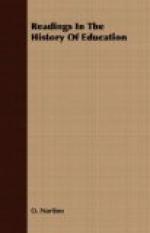(x) First objection:
Why is the projecting
continent
then, not circular, since the
motion
of these stars is circular?
Answer:
Because the material did not
suffice
for so great an elevation.
(y)
Second objection: Why is this elevation
in
this particular place?
Answer:
Because God whose ways are
inscrutable,
willed it so.
We
should therefore desist from examining
too
closely the reasons, which we
can
never hope to fathom.
D. Refutation of the original arguments:
Reason 1. Invalid because
Earth and Water are spheres
with the same center.
Reason 2. Invalid because
of the external influence of
Universal Nature, counteracting
the internal influence
of Particular Nature.
Reason 3. Invalid because
it is sphericity of the sea and
not the lowness of the land
which interferes with one’s
view at sea.
Reason 4. Invalid because
Water does not flow to the
tops of mountains, but ascends
thither in the form of
vapors.
Reason 5. Invalid because
Water imitating the moon in
one respect, need not imitate
it in all.[61]
This brief obviously illustrates much more than the form of the mediaeval Disputation. It leaves one in no doubt as to the difference between the natural science of the Middle Ages and that of our own time. It also illustrates the weakness of the scholastic method when applied to questions which modern science would settle by experiment. The argument abounds in misstatements of fact, the conclusion is incorrect, and the “reasoning” by which it is reached can be described, from the modern point of view, only as grotesque. The weakness of the method was recognized by Roger Bacon so early as the thirteenth century. The growing recognition of its futility finds repeated expression in the sixteenth and seventeenth centuries, notably in the New Method (Novum Organum) of Francis Bacon.
Like the scholastic method and the worship of Aristotle, the Disputation fell into disrepute because of the extravagant lengths to which it was carried. The following sarcastic criticism by the Spanish scholar, Juan Luis Vives (1462-1540), is one illustration of the growing revolt of his times against it:
Disputations, also, to no slight degree have blinded judgment. They were instituted originally (but only among young men) to stimulate mental vigor, often torpid, and to make young men keener in their studies, so that they might either conquer or not be conquered, and also that the instruction received from their teachers might be more deeply impressed upon them.




